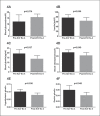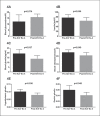Potential Role of Hypothalamic and Plasma Ghrelin in the Feeding Behavior of Obese Type 2 Diabetic Rats with Intraventricular Glucagon-Like Peptide-1 Receptor Agonist Intervention
- PMID: 33341811
- PMCID: PMC7983563
- DOI: 10.1159/000509956
Potential Role of Hypothalamic and Plasma Ghrelin in the Feeding Behavior of Obese Type 2 Diabetic Rats with Intraventricular Glucagon-Like Peptide-1 Receptor Agonist Intervention
Abstract
Objective: To investigate the relationship of central and peripheral ghrelin during an exendin-4 (Ex-4) intervention to feeding in obese type 2 diabetic rodents.
Methods: Animal models of diet-induced obesity (DIO) and type 2 diabetes were developed using male Sprague-Dawley rats fed with a high-fat diet and induced into DIO-streptozotocin diabetic rats. Ex-4 or the glucagon-like peptide-1 (GLP-1) receptor agonist exendin fragment-[9-39] (Ex-9) was intracerebroventricularly (ICV) administered. Multivariate linear regression analysis was performed to investigate potential predictors of food intake after Ex-4 administration.
Results: ICV administration of Ex-4 significantly inhibited feeding and decreased weight, plasma active ghrelin, hypothalamic ghrelin, and gastric ghrelin levels. The changes in hypothalamic ghrelin and plasma ghrelin could predict the amount of 8-h average food intake. Central preadministration of Ex-9 followed by treatment with Ex-4 could inhibit the decrease in feeding at 0.5, 2, and 8 h. It could also inhibit the decrease in hypothalamic ghrelin at 0.5, 2, and 8 h, as well as in plasma and gastric ghrelin at 2 and 8 h.
Conclusions: In a GLP-1 receptor-dependent manner, central and peripheral ghrelin play a vital role in the inhibition of feeding by Ex-4 administration. Hypothalamic ghrelin, but not plasma ghrelin, may be involved in central Ex-4 inhibition of feeding in the very early feeding period.
Keywords: Appetite regulation; Glucagon-like peptide-1 receptor agonist; Hypothalamic ghrelin; Obesity; Type 2 diabetes.
© 2020 The Author(s) Published by S. Karger AG, Basel.
Conflict of interest statement
The authors declare no conflict of interest.
Figures





References
-
- NamKoong C, Kim MS, Jang BT, Lee YH, Cho YM, Choi HJ. Central administration of GLP-1 and GIP decreases feeding in mice. Biochem Biophys Res Commun. 2017 Aug;490((2)):247–52. - PubMed
-
- Pérez-Tilve D, González-Matías L, Alvarez-Crespo M, Leiras R, Tovar S, Diéguez C, et al. Exendin-4 potently decreases ghrelin levels in fasting rats. Diabetes. 2007 Jan;56((1)):143–51. - PubMed
-
- Seo S, Ju S, Chung H, Lee D, Park S. Acute effects of glucagon-like peptide-1 on hypothalamic neuropeptide and AMP activated kinase expression in fasted rats. Endocr J. 2008 Oct;55((5)):867–74. - PubMed
Publication types
MeSH terms
Substances
LinkOut - more resources
Full Text Sources
Medical

